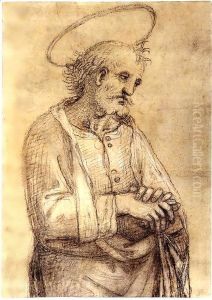Giannicola di Paolo Paintings
Giannicola di Paolo was an Italian painter from the Renaissance period, whose life and work were deeply embedded in the artistic milieu of Perugia, a city in the Umbria region of Italy. Born around 1460, Giannicola di Paolo emerged as an artist in a time when the Italian Renaissance was flourishing, a period marked by a rebirth of interest in the classical art and literature of ancient Greece and Rome. This era saw the production of art that emphasized harmony, proportion, and a detailed observation of the human condition, characteristics that can be found in Giannicola's works.
Giannicola was influenced by the works of Perugino (Pietro Vannucci), one of the leading artists of the time and a native of the same region. It is known that he was an apprentice in Perugino's workshop, a common practice for young artists then, which allowed them to learn their craft under the guidance of established masters. This mentorship is evident in Giannicola's adoption of Perugino's graceful figures, serene landscapes, and a delicate use of color. However, Giannicola di Paolo managed to develop a personal style that distinguished his works from those of his contemporaries and even his mentor. His paintings often exhibit a depth of emotion and a nuanced treatment of religious themes, reflective of the spiritual and intellectual currents of his time.
Throughout his career, Giannicola di Paolo contributed significantly to the artistic heritage of Perugia. He was active in decorating churches and public buildings, creating altarpieces, frescoes, and panel paintings that often depicted religious scenes, imbued with a sense of piety and devotion characteristic of the period. Despite the lack of extensive documentation about his life, it is clear that his work was appreciated in his own time, allowing him to receive commissions from both ecclesiastical and secular patrons.
Giannicola di Paolo's legacy is somewhat overshadowed by the giants of the Renaissance such as Leonardo da Vinci, Michelangelo, and Raphael, yet his contributions to the Umbrian School of painting are significant. His works can be seen as a bridge between the early Renaissance and the High Renaissance, reflecting the transition in artistic styles and sensibilities. Giannicola di Paolo died around 1544, leaving behind a body of work that, while not vast, plays an important role in the tapestry of Renaissance art. His paintings are preserved in various museums and collections, serving as a testament to the enduring appeal of Renaissance art and its capacity to convey the depth of human experience through beauty and craftsmanship.
